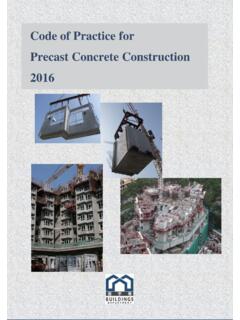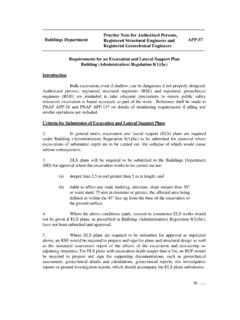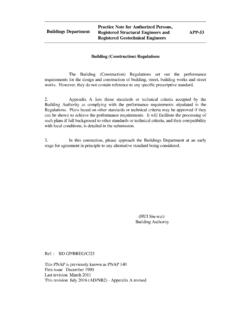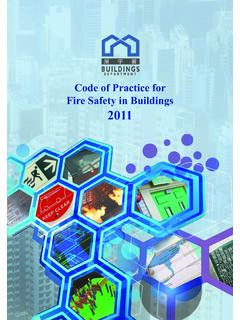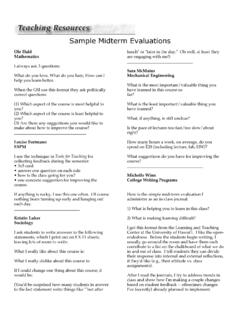Transcription of Code of Practice for Building Works for Lifts and ...
1 (2020 Edition). CODE OF Practice . FOR. THE DESIGN AND CONSTRUCTION OF BUILDINGS. AND Building Works . FOR. THE INSTALLATION AND SAFE USE OF. Lifts AND ESCALATORS. 2011. (2020 Edition). Building AUTHORITY. HONG KONG. FOREWORD. This Code of Practice sets out the technical standards for Building Works carried out or to be carried out to accommodate Lifts and escalators for the guidance of Authorized Persons, Registered Structural Engineers and other persons responsible for or interested in the design and construction of buildings. It also provides guidance on the notices to be displayed to warn occupants and users of buildings, where Lifts and escalators are installed, of the danger that may arise from using, operating and maintaining Lifts and escalators. As a general rule, compliance with the provisions promulgated herein may be deemed to satisfy the requirements of regulation 9A of the Building (Construction) Regulations.
2 The Building Authority may, however, accept other standards or provisions if he is satisfied that they are capable of equivalent performance. This edition of the Code of Practice incorporates various amendments made and promulgated through the relevant Practice Note for Authorized Persons, Registered Structural Engineers and Registered Geotechnical Engineers since its first publication in 1993. First issue : July 1993. Last revision : November 2011. This revision : September 2020. CONTENTS. Page 1. General 1. Scope 1. Definitions 1. Application to service Lifts 2. 2. Dimensions for lift installations 2. Minimum dimensions for lift installations 2. Modifications from the minimum dimensions for lift installations 2. Machine-room-less lift installations 2. 3. Lifts 2. Liftwell enclosure 2. Liftwell inspection and emergency doors and inspection traps 2.
3 Ventilation of a liftwell 6. Walls, floor and ceiling of a liftwell 6. Construction of the walls of liftwells facing a car entrance 6. Protection of any space located below a car or a counterweight 7. Well containing cars and counterweights belonging to several Lifts or service Lifts 7. Lift pit 7. Exclusive use of a liftwell 8. Outside of a liftwell 8. Machine and pulley rooms 8. Machine and pulley room access 9. Structural strength and floor surface of machine and pulley rooms 9. Dimensions of machine and pulley rooms 9. Doors and trap doors to machine and pulley rooms 10. Other openings in machine and pulley rooms 10. Handling of equipment in machine rooms and liftwells 10. 4. Service Lifts 11. Liftwell enclosure 11. Liftwell inspection doors and inspection traps 11. Ventilation of a liftwell 11. Walls, floor and ceiling of a liftwell 11.
4 Construction of walls of liftwells facing a car entrance 11. Protection of any space located below a car or a counterweight 11. Well containing cars and counterweights belonging to several Lifts or service Lifts 11. Lift pit 11. Exclusive use of a liftwell 12. Outside of a liftwell 12. Machine rooms and enclosures 12. 5. Escalators 13. Machine rooms and driving and return stations 13. Steps and landings 14. Obstructions 14. Appendix : Sample of general note for lift machine room clearances to be provided on 15. general Building plans 1. GENERAL. Scope This Code of Practice deals with Building Works related to Lifts and escalators in general. Standards on fire resisting construction for all Building Works including Building Works to accommodate Lifts and escalators are specified in Part C of the Code of Practice for Fire Safety in Buildings.
5 Electrical and mechanical standards are specified in the Code of Practice on the Design and Construction of Lifts and Escalators and the Code of Practice for Lift Works and Escalator Works issued under the Lifts and Escalators Ordinance. For firemen's Lifts , some requirements of regulation 41B of the Building (Planning) Regulations and the standards specified in Part D of the Code of Practice for Fire Safety in Buildings may also be applicable. Definitions Escalator , lift and service lift have the same meaning as assigned to them respectively in the Lifts and Escalators Ordinance (Cap. 618). Open air has the same meaning as assigned to it in regulation 2(1) of the Building (Planning) Regulations. For ease of reference, the above definitions are reproduced below. Escalator means: (a) an inclined, continuous stairway that is driven by mechanical power and is used for (i) raising passengers.
6 (ii) lowering passengers; or (iii) both of the purposes mentioned in subparagraphs (i) and (ii); or (b) a passenger conveyor that is a continuous walkway driven by mechanical power and is used for conveying passengers on the same or between different traffic levels;. Lift means: (a) a lifting machine or appliance having a carrier the direction of movement of which is restricted by one or more guides; or (b) a mechanized vehicle parking system, but does not include an escalator;. Service lift means a lift the rated load of which is not more than 250 kg and that has a car or cage of which the floor area is not more than 1 m2 and the height is not more than m;. Open air means a space which: (a) is vertically uncovered and unobstructed;. (b) is not less, in any horizontal dimension, than m; and (c) where such space is enclosed on 4 sides, has a horizontal area of not less than 1 m2 for every 6 m of the mean height of the walls enclosing the space.
7 -1- Application to service Lifts The standards specified in Sections 2 and 3 shall be adopted for all Lifts to which regulation 9A. of the Building (Construction) Regulations applies, except service Lifts . The standards for service Lifts are laid down in Section 4. 2. DIMENSIONS FOR LIFT INSTALLATIONS. Minimum dimensions for lift installations The minimum dimensions of well , entrance , pit, machine room and headroom are given in Table 1. Modifications from the minimum dimensions for lift installations If there are justifications to deviate from, or practical difficulties to comply with, the minimum dimensions given in Table 1, then the requirements may be modified provided that a registered lift engineer or a person authorized by a registered lift contractor confirms in writing that: (a) the installations can be accommodated in the proposed lift wells and machine rooms.
8 (b) any future maintenance, repair, major alteration, replacement, examination and testing of the Lifts can be carried out in the proposed liftwells and machine rooms safely and without difficulty; and (c) the lift installations are in full compliance with the Code of Practice on the Design and Construction of Lifts and Escalators issued under the Lifts and Escalators Ordinance. Machine-room-less lift installations The requirements on machine room minimum dimensions and overall headroom are not applicable to machine-room-less lift installations if the concerned lift models are approved by the Director of Electrical and Mechanical Services. Particulars of the lift models used and relevant approval shall be indicated on the general Building plans. 3. Lifts . Liftwell enclosure Each well shall be totally enclosed by imperforate walls, floor and ceiling, as defined in paragraph and in accordance with Part C of the Code of Practice for Fire Safety in Buildings.
9 Liftwell inspection and emergency doors and inspection traps Inspection and emergency doors, and inspection traps to a well, shall not be permitted except on grounds of safety to users or the requirements of servicing. Inspection doors shall have a minimum height of m and a minimum width of 600 mm. -2- Table 1 Minimum dimensions for lift installations Rated No. of Rated Well min. Clear Pit Headroom Machine room minimum Overall Car internal sizes load Passengers speed dimensions entrance depth dimensions (see Note 5) headroom Max. Height Width Depth Width Depth Width Height Area Width Depth Height Area Cw Cd Ww Wd Ew Eh Ph Sh Ra Rw Rd Rh Uh Ca 2 2. Kg m/s mm mm m mm mm mm mm mm mm mm m mm mm mm mm 1 100 1 400 2 300 1 800 2 100 800 2 100 1 700 4 450 15 2 500 3 700 2 600 7 250. 630 8 1 100 1 400 2 300 1 800 2 100 800 2 100 1 700 4 650 15 2 500 3 700 2 600 7 450.
10 1 100 1 400 2 300 1 800 2 100 800 2 100 1 800 4 850 15 2 500 3 700 2 600 7 650. 1 400 1 250 2 300 1 800 2 100 800 2 100 1 700 4 450 15 2 500 3 700 2 600 7 250. 680 9 1 400 1 250 2 300 1 800 2 100 800 2 100 1 700 4 650 15 2 500 3 700 2 600 7 450. 1 400 1 250 2 300 1 800 2 100 800 2 100 1 800 4 850 15 2 500 3 700 2 600 7 650. 1 400 1 350 2 300 1 900 2 300 800 2 100 1 700 4 450 15 2 500 3 700 2 600 7 250. 1 400 1 350 2 300 1 900 2 300 800 2 100 1 700 4 650 15 2 500 3 700 2 600 7 450. *800 10 1 400 1 350 2 300 1 900 2 300 800 2 100 1 800 4 850 15 2 500 3 700 2 600 7 650. 1 400 1 350 2 300 1 900 2 300 800 2 100 2 800 5 650 15 3 200 4 900 2 600 8 450. 1 400 1 350 2 300 1 900 2 300 800 2 100 2 800 5 650 15 3 200 4 900 2 600 8 450. 1 600 1 350 2 300 2 100 2 100 900 2 100 1 700 4 450 15 2 500 3 700 2 600 7 250. 1 600 1 350 2 300 2 100 2 100 900 2 100 1 700 4 650 15 2 500 3 700 2 600 7 450.


